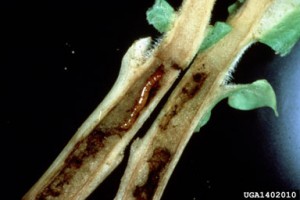Scouting for Tobacco Soil Insect Pests
go.ncsu.edu/readext?307212
en Español / em Português
El inglés es el idioma de control de esta página. En la medida en que haya algún conflicto entre la traducción al inglés y la traducción, el inglés prevalece.
Al hacer clic en el enlace de traducción se activa un servicio de traducción gratuito para convertir la página al español. Al igual que con cualquier traducción por Internet, la conversión no es sensible al contexto y puede que no traduzca el texto en su significado original. NC State Extension no garantiza la exactitud del texto traducido. Por favor, tenga en cuenta que algunas aplicaciones y/o servicios pueden no funcionar como se espera cuando se traducen.
Português
Inglês é o idioma de controle desta página. Na medida que haja algum conflito entre o texto original em Inglês e a tradução, o Inglês prevalece.
Ao clicar no link de tradução, um serviço gratuito de tradução será ativado para converter a página para o Português. Como em qualquer tradução pela internet, a conversão não é sensivel ao contexto e pode não ocorrer a tradução para o significado orginal. O serviço de Extensão da Carolina do Norte (NC State Extension) não garante a exatidão do texto traduzido. Por favor, observe que algumas funções ou serviços podem não funcionar como esperado após a tradução.
English
English is the controlling language of this page. To the extent there is any conflict between the English text and the translation, English controls.
Clicking on the translation link activates a free translation service to convert the page to Spanish. As with any Internet translation, the conversion is not context-sensitive and may not translate the text to its original meaning. NC State Extension does not guarantee the accuracy of the translated text. Please note that some applications and/or services may not function as expected when translated.
Collapse ▲When to scout for soil insect pests
Damage from soil-dwelling insect pests, such as wireworms and white fringed beetles, typically develops in the first three to four weeks following transplant. Scout plants for at least month following transplant.
What part of the plant to scout for soil insect pests
Soil-dwelling insect pests damage roots and stems, so damage is not visible at the surface.
How to scout for soil insect pests
Plants that appear stressed or stunted can be dug up and observed for either chewing and boring damage or insect presence. Be aware that other issues can cause plant stunting, including herbicide damage or carryover, some insecticides, salt injury from granular fertilizer, and weather. Rule out these potential causes of injury before digging large numbers of plants.

Wireworms tunneling through the stem of a small tobacco plant. Photo: R.J. Reynolds Tobacco Company Slide Set, R.J. Reynolds Tobacco Company. Bugwood.org
Soil insect pest thresholds
Rescue treatments, or treatments applied after damage occurs, are not effective for soil insects in tobacco. However, because damage from soil insects is relatively rare in tobacco, preventative insecticide use pretransplant is also not recommended unless a field has a history of soil insect damage. Crop rotation is another means of soil insect control.
If greater than 10% of plants are killed due to soil-dwelling insect feeding, replanting is recommended. If less than 10% of plants die due to insect feeding, replanting is not necessary.


